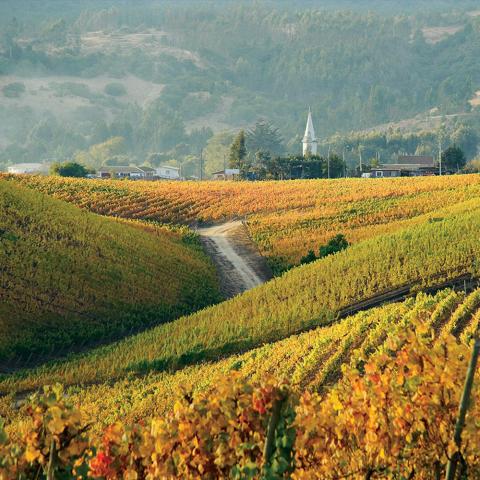Chile

Since December 1994, the Chilean wine producing regions have been officially defined as follows, to help identify the different features of wines produced in different parts of Chile's variable geography.
Atacama
Named after the Atacama Region administrative territory, this region is divided into two valleys, Copiapó and Huasco, both of which are coterminous with the provinces of the same names. The region is known primarily for its Pisco and table grapes, but in the 1950s wine began to be produced on a small scale around Copiapó. Examples of wine from these valleys include "Vino Copiapino" (literally, "Copiapó's Wine") by Viña Fajardo and Pajarete wine, a varietal from Spain that is now produced successfully in the Huasco Valley.
Coquimbo
The Coquimbo Region contains has three wine-producing sub regions: Elqui, Limarí and Choapa, all are coterminous with the provinces of the same name. The region's vineyards extend from the Pacific Ocean in the west to the Andes Mountains in the east, rising to an altitude of 6,500 feet. Wine production began in the Elqui Valley in the 1990s when Chilean wine producers began to look at potential viticulture sites outside the Chilean Central Valley. Since then, 286 hectares of vines have been planted, mostly along the River Elqui valley, where grape growers have access to high-quality water for irrigation. The region is characterized by a sunny, desert-like climate, less than 70 mm of annual rainfall, dry rocky terrain, steep valleys and temperate hills cooled by strong winds from the Pacific Ocean and the Andes Mountains, producing excellent results for varietals like Syrah.
Aconcagua
The administrative region of Valparaíso contains two wine-producing subregions, the Aconcagua and Casablanca valleys. The Aconcagua Valley is coterminous with the province of San Felipe de Aconcagua Province while the Casablanca Valley is coterminous with the commune of that name. The Panquehue commune is also gradually developing a reputation for high quality wine production. Vines were first planted here in the mid-1980s during the revitalization of the Chilean wine industry and the area quickly became known for its white wines, most notably Sauvignon blanc and Chardonnay, as well as Pinot noir, which thrives in its cooler climate.
Central Valley Region
The Central Valley spans the O'Higgins (VI) and Maule (VII) administrative regions as well as the Metropolitana Region. Within it are four subregions: the Maipo Valley, the Rapel Valley, the Curicó Valley and the Maule Valley. This is Chile's most productive and internationally known wine region, due in large part to its proximity to the country's capital, Santiago. It is located directly across the Andes from Argentina's most well known wine region, Mendoza Province The soil of Maipo Valley is noted for high salinity stemming from irrigation from the Maipo river and low potassium level which has some impact on the grapevines. Vineyards in the Maule also suffer from low potassium as well as deficient nitrogen levels. Advances in viticultural techniques have helped vineyards in these regions compensate for some of these effects.
Southern Chile
Lying within the Bío Bío Administrative Region (VIII), this area includes two wine-producing sub regions: the Itata Valley and the Bío Bío Valley. The region is primarily known for its mass-produced boxed Pais wine and jug wines, though the Concha y Toro Winery has experimented with Gewürztraminer from this region. Chile's southern wine regions have more rainfall, lower average temperatures and fewer hours of sunlight than the northern wine regions.



